🌊🍩⚓The Virgin of Carmen Fiestas
The cooling sea breezes are a welcome relief on the Spanish coastline this July as they celebrate the patron saint of the sea. Also a scrummy recipe for rosquillas (donuts) of the Virgen del Carmen.
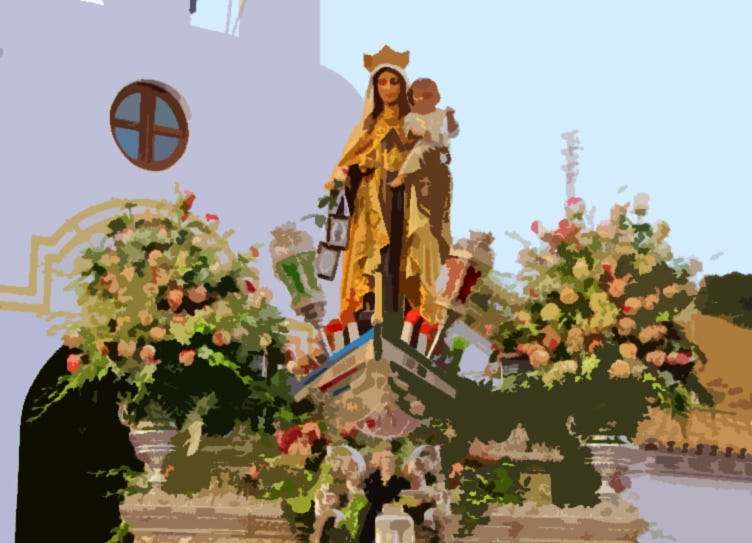
For someone arriving in Spain with a non-Catholic background, the sheer number of Virgin Marys that seem to make an appearance every festival and religious observance can be baffling. Are they all the same woman? That’s a lot of virginity. I personally found the retinue of saints quite overwhelming, but the assortment of Marys was an outright mystery.
Pre-internet meant I had to rely on Spaniards to explain the differences but most of the time they didn’t really know the answer to my questions either. It’s just the way it was and always had been. Was the Virgin of Sorrows the same as the Virgin of Hope or the Virgin of the Dove? Was the Virgin of the Remedies who cured people of the plague the same Virgin of Guadalupe of Caceres who also heals, but is black?
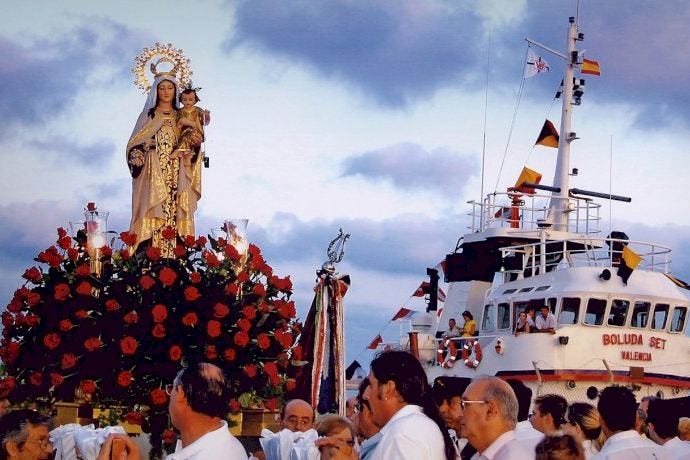
Mary and Her Many Hats
Like Mary, we don't always wear the same clothes. It all depends on the occasion, and you dress accordingly. And it can all be explained with “Marian devotion”.
In Catholicism, Marian devotion refers to the mysteries, apparitions, gifts or attributes of Mary, the virgin mother of Jesus. Spain's history is filled with Marian apparitions and devotions which are often linked to historical events and cultural traditions.
There are the devotions relating to the mysteries or passages of life of Mary (or at least those invented by the Church), such as the Immaculate Conception, the Annunciation, the Assumption, etc. Then there are those relating to abstract truths such as Hope and Charity, or her psychological states as in Sorrows, Loneliness… The Virgin Mary is also associated with fruits, flowers, and birds, or geographical features where her sanctuaries were erected, such as Fatima, Lourdes, and of course, Carmen.
Interestingly, the Catholic Church in Spain has accrued the most canonically crowned Marian images in the world, with over 150 formally recognised by the Pope or the Vatican. This is far more than any other Catholic country including Italy that can only claim around 100. The Virgin Mary has become an integral part of almost every festival in Spain, if not the only reason for the festival.
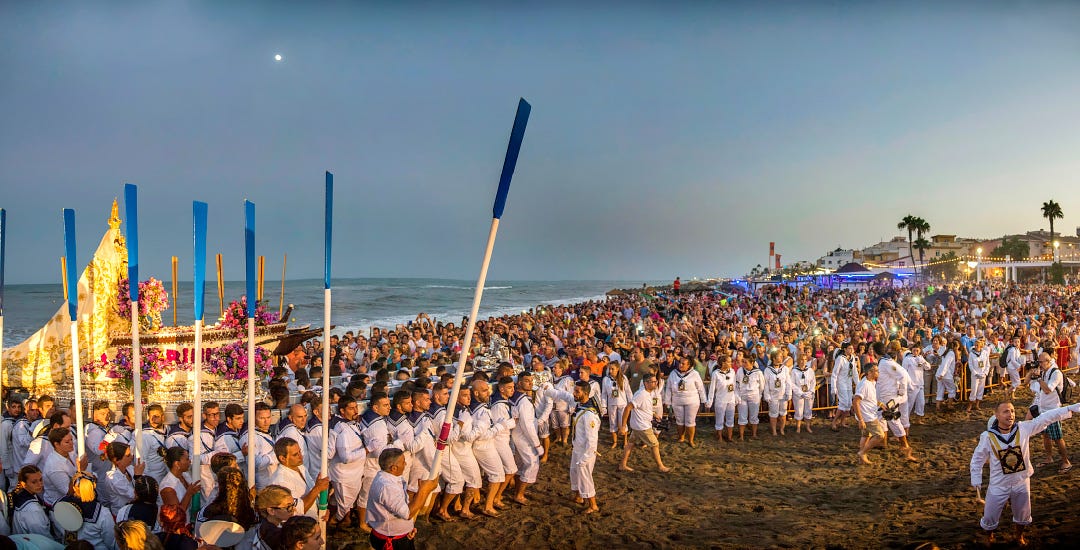
Virgin of the Sea
Which brings us to the Virgin of Carmen, Queen of the Seas, and patron saint and protector of sailors and fisherpersons.
The hat the Virgin wears in this advocation comes from the veneration of Mary on Mount Carmel, Israel, by early Christian hermits who built a chapel in her honour. These hermits, inspired by the prophet Elijah, chose the mountain as a place to spend the rest of the lives in solitude, prayer, and contemplation of the Virgin Mary.
In the 13th century, the Carmelite hermits migrated to Europe to escape the wars in the Holy Land, whereby spreading the Marian devotion throughout Christendom. From then on visions and apparitions of the Virgin further spread her popularity, and stories and legends emerged about her intervention in sea-related disasters.
Sailors and fishermen who were saved from stormy seas and shipwrecks attributed their miraculous salvation to Mary of Carmen. In the 18th century, the Spanish Admiral, Antonio Barcelo Pont de la Terra, went so far as to officially change the patronship of Spanish sailors from Saint Elmo to the Virgen del Carmen. Maybe he hadn’t heard about the destruction of the Spanish Armada in 1588… 😏
Today, statues of the Virgin are carried on boats, blessed, and venerated by sailors seeking her protection and safe passage. Villages and towns up, down, and across the coastlines of Spain celebrate her feast day on July 16th in maritime processions, pilgrimages, and plenty of partying.
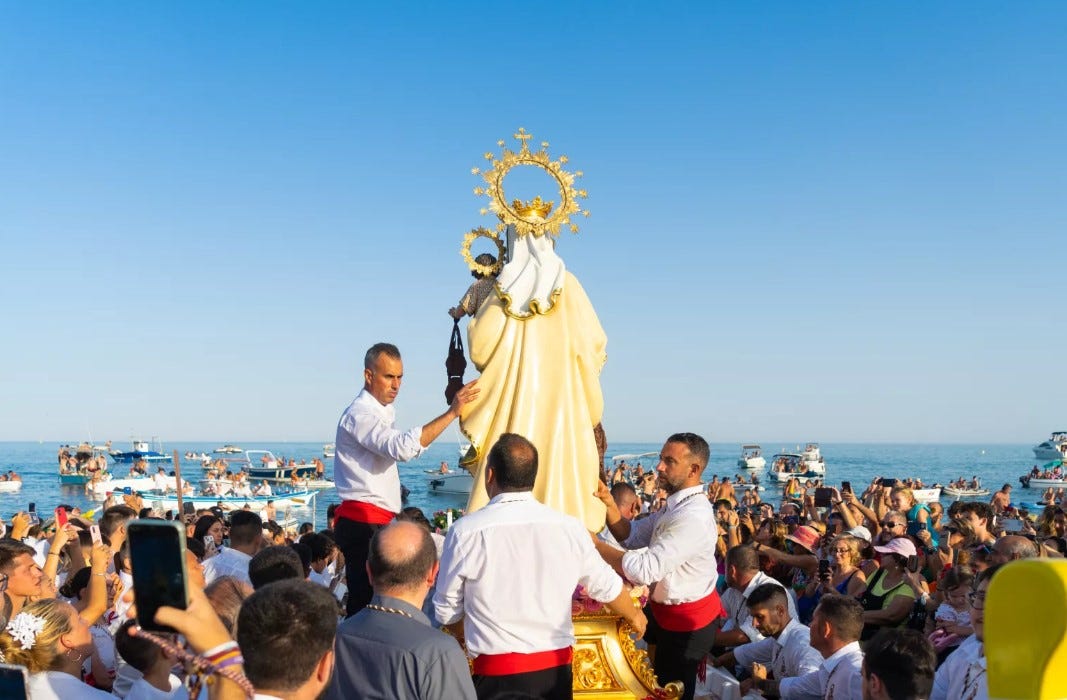
The Carmen Festivals
There is no better place to be in the throes of a Spanish summer than by the sea. During the Virgin of Carmen Festivals, visitors flock to the beaches of Galicia to bathe in the aroma of grilled sardines or to marvel at the bounties of the sea in full display in the seafood market and fair of Santander in Cantabria.
Barceloneta Beach in Barcelona holds large celebrations on the 16th, and the busy fishing port of Santa Pola, Alicante, holds a floral offering to all those who lost their lives at sea, as well as the obligatory procession with the statue of the Virgin and live music. Towns all along the Catalan and Valencian coast celebrate the Virgin with a Mass, floral offerings, maritime processions, and fireworks. In Torrevieja a paella competition is organised in the fish market because….why not?
Further south, in Malaga, the Virgin of Carmen is carried by local sailors dressed in traditional marengo suits consisting of black trousers, a white shirt and a red sash. She is paraded through the town before being carried out to sea and placed on a jabega – a lavishly decorated fishing boat – from which she will bless the sea and the fishing grounds.
These days, the Virgin of Carmen is not just expected to protect sailors and fisherpersons, but also scuba divers. The Association of Our Lady of Carmen, Patron Saint of Scuba Divers of Malaga celebrates this festival with divers carrying the Virgin effigy to the beach of La Malagueta where she is submerged to the bottom of the bay.
It’s not just the coast where the Virgin of Carmen is venerated. There are various towns and neighbourhoods around the country where she is honoured as patron saint. One such neighbourhood can be found in Madrid, land-locked capital of Spain, and it is there where we go for this week’s recipe.
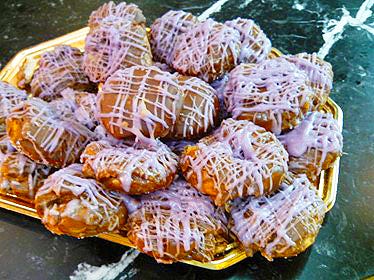
The Rosquillas del Carmen
The elegant district of Chamberi, Madrid, known for its historic charm and artistic scene, celebrates the Carmen Festival during five days with cultural activities, a fairground, religious events, live music, workshops, and theatre.
The donuts are an invention of beloved pastry chef, Esteban Fernandez, local of the Chamberi district and fourth generation of pastry chefs, who died in 2021 at the age of 61. The famed pastelero was known for his variety of typical holiday pastries, especially the King’s Roscon cake which would draw queues up and down the street at Christmas time.
These rosquillas were created especially for the festival and given away to the locals after Mass on the day of the Virgin of Carmen. While Esteban himself may no longer be satiating the sweet tooth of the locals, his pastries can still be found at Calle Juan Bautista de Toledo, number 6, in Charmartin.
‘Rosquilla’ roughly translates to ‘donut’, but the Spanish donut is less cakey and sweet, and more bready and chewy. The sweetness usually comes from the sugar dusting or icing glaze that is added later to the cooked pastry.
Rosquillas have a long history in Spain going back to ancient Mediterranean civilisations. The name can be traced back to the Latin “rotae” meaning “wheel” or “ring”. Spanish rosquillas are usually flavoured with anise, almonds, lemon zest or cinnamon and can be fried or baked.
This recipe is a variation on the theme, with orange zest replacing lemon which goes better with the chocolate icing. The purple drizzle is a nod to the colour often associated with the Virgin of Carmen.
Ingredients:
250 grams of flour
100 grams of sugar
3 eggs
1/2 teaspoon dried yeast
6 tablespoons of olive oil
Zest of one orange finely chopped and/or a few drops of orange essence
100g cooking chocolate melted in a Bain Marie with a little milk.
Purple icing. (powdered sugar, water and purple colouring)
Preparation:
Beat the eggs with the sugar until light and creamy.
Add the oil, yeast, and the flour. Mix well until you obtain a smooth dough. Add extra flour if necessary.
Cover the bowl with a cloth and let the dough rest for an hour in the refrigerator or a cool place.
Grease your hands with oil and divide the dough into twelve parts. Form balls before flattening them slightly. Make a hole in the centre to shape them into donuts.
Place the donuts on a greased baking tray so they are separated from each other.
Cook in the oven at around 200 degrees C (390 F) until golden.
Once set and cooled, dip them in the melted chocolate mixture.
Top with strands of purple icing.
If seafood is more your thing during the Carmen festivities, please check out Recipes where you can find plenty of fishy dishes such as fried fish, saffron fish soup, garlic prawns, cod with tomato, trout salad, Valencian paella, Galician broth, and prawn-stuffed piquillo peppers. Buen Provecho!! 🤤



